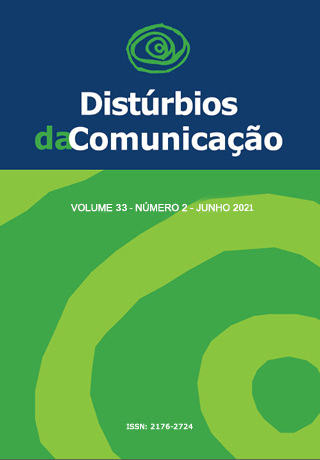Descriptive study on language assessment instruments published in Brazilian Speech, Language and Hearing Sciences journals
DOI:
https://doi.org/10.23925/2176-2724.2021v33i2p195-203Keywords:
Language tests, Diagnosis, Validation study, Speech-Language and Hearing SciencesAbstract
Purpose: to describe speech therapy instruments of oral language evaluation published in Brazilian periodicals, and to analyze the validation procedures used. Method: Casuistry: All volumes from the periodicals Audiology Communication Research (ACR), Revista CEFAC (CEFAC), Revista Distúrbios da Comunicação (DIC) and Communication Disorders and Sciences (CoDAS) published from January/2016 to July/2019. Publishing’s were selected from titles, abstracts and descriptors, to full text readings and then were categorized according to the following variables: periodical, volume/number, date, purpose (elaboration or translation/adaptation of oral language evaluation instruments), original language (in translation/adaptation cases), sample size and statistics techniques used (validity and reliability). Results: Most of the articles were intended for children and are intended to develop a new instrument. The predominance of studies that presented content validation is noteworthy; however, few performed the reliability test by alpha Cronbach. It was also found that only one study performed a sensitivity and specificity test and no study published in the studied period performed a predictive value calculation, likelihood ratio or ROC curve. Conclusion: the results indicate limitations in validation studies and suggest caution regarding the use of language assessment instruments, both in clinical activity and in research.
Downloads
References
Alexandre NMC, Coluci MZO. Validade de conteúdo nos processos de construção e adaptação de instrumentos de medidas. Ciênc. saúde coletiva. 2011; 16(7): 3061–8.
Salmond SS. Evaluating the Reliability and Validity of Measurement Instruments: Orthop Nurs. 2008; 27(1): 28–30.
Giusti E, Befi-Lopes DM. Translation and cross-cultural adaptation of instruments to the Brazilian Portuguese language. Pró-Fono R. Atual. Cient. 2008; 20(3): 207–10.
Ceron MI, Gubiani MB, Oliveira CR de, Keske-Soares M, Ceron MI, Gubiani MB, et al. Evidence of validity and reliability of a phonological assessment tool. CoDAS. 2018; 30(3): e20170180.
Gurgel LG, Kaiser V, Reppold CT. The search for validity evidence in the development of instruments in speech therapy: a systematic review. Audiol. Commun. Res. 2015; 20(4): 371-83.
Pagliarin KC, Oliveira CR de, Silva BM da, Calvette L de F, Fonseca RP. Instrumentos para avaliação da linguagem pós-lesão cerebrovascular esquerda. Rev. CEFAC. 2013; 15(2): 444–54.
Lindau TA, Lucchesi FDM, Rossi NF, Giacheti CM. Systematic and formal instruments for language assessment of preschoolers in brazil: a literature review. Rev. CEFAC. 2015; 17(2): 656–62.
Casarin FS, Pagliarin KC, Koehler C, Oliveira CR de, Fonseca RP. Instrumentos de avaliação breve da comunicação: ferramentas existentes e sua aplicabilidade clínica. Rev. CEFAC. 2011; 13(5): 917–25.
Guimarães C da S, Cruz-Santos A, Almeida L. Adaptation of the Parent Report Language Use Inventory for 18- to 47-months-old children to European Portuguese: a pilot Study. Audiol. Commun. Res. 2013; 18(4): 332–8.
Machado FP, Palladino RRR, Cunha MC, Machado FP, Palladino RRR, Cunha MC. Adaptation of the Child Development Clinical Risk Indicators instrument to retrospective parent report. CoDAS. 2014; 26(2): 138–47.
Costa VBS da, Harsányi E, Martins-Reis V de O, Kummer A. Translation and cross-cultural adaptation into Brazilian Portuguese of the Children’s Communication Checklist-2. CoDAS. 2013; 25(2): 115-9.
Bento-Gaz ACP, Befi-Lopes DM, Bento-Gaz ACP, Befi-Lopes DM. Adaptation of Clinical Evaluation of Language Functions - 4th Edition to Brazilian Portuguese. CoDAS. 2014; 26(2): 131–7.
Savoldi A, Ceron MI, Keske-Soares M. What are the best words to compose an evaluation phonological instrument? Audiol. Commun. Res. 2013; 18(3): 194-202.
Cunha MC, Oliveira GR. Publicações brasileiras em periódicos científicos: níveis de evidência científica da produção na área de linguagem. In: Tratado de linguagem: perspectivas contemporâneas. 1ª ed. Ribeirão Preto: Booktoy; 2017: 293-9.
Sireci SG. The Construct of Content Validity. Soc. Indic. Res. 1998; 45: 83–117.
Monteiro GTR, Hora H. Pesquisa em saúde pública: como desenvolver e validar instrumentos de coleta de dados. Curitiba: Appris; 2014.
McLeod S, Verdon S. A review of 30 speech assessments in 19 languages other than English. Am J Speech Lang Pathol. 2014; 23(4): 708-23.
Sá TBF de, Lima RF de, Mattar T de LF, Ciasca SM. Construction of an instrument to assess oral language comprehension of children from 2 to 6 years. Disturb Comun. 2018; 30(1): 158–69.
Berti LC. PERCEFAL: an instrument to assess identification of phonological contrasts in Brazilian Portuguese. Audiol. Commun. Res. 2017; 22: e1727
Colina S, Marrone N, Ingram M, Sánchez D. Translation Quality Assessment in Health Research: A Functionalist Alternative to Back-Translation. Eval Health Prof. 2017; 40(3): 267–93.
Souza AC de, Alexandre NMC, Guirardello E de B. Propriedades psicométricas na avaliação de instrumentos: avaliação da confiabilidade e da validade. Epidemiol Serv Saúde. 2017; 26: 649-59.
Friberg JC. Considerations for test selection: How do validity and reliability impact diagnostic decisions? Child Lang Teach Ther. 2010; 26(1): 77–92.
Downloads
Published
Issue
Section
License
Copyright (c) 2021 Maria Claudia Cunha, Mabile Francine Ferreira Silva, Tatiane Ichitani, Fernanda Prada Machado

This work is licensed under a Creative Commons Attribution 4.0 International License.









